A sales pipeline is a predetermined series of steps that help you push the sales forward. It is often a graphical chart to represent the lead journey. Pipeline management is crucial to keep a sales pipeline healthy, especially while adding new leads.

What is sales pipeline management?
Sales pipeline management is the process of maintaining a healthy sales pipeline by tracking the flow of leads at every stage.
Seems straightforward, but it isn’t!
If you see, taking a single lead through each step of the sales pipeline is relatively straightforward. You know your goals, you know the requirements, and you only have to keep track of where that person is within the pipeline. But, adding the second and third lead will make the process complicated. Because you will now have to track each individual – not just where they are in the pipeline, but also their wants and needs, and what is necessary to get them progressed.
When you reach the level of having a hundred or more people in your sales pipeline, managing them becomes a lot harder.
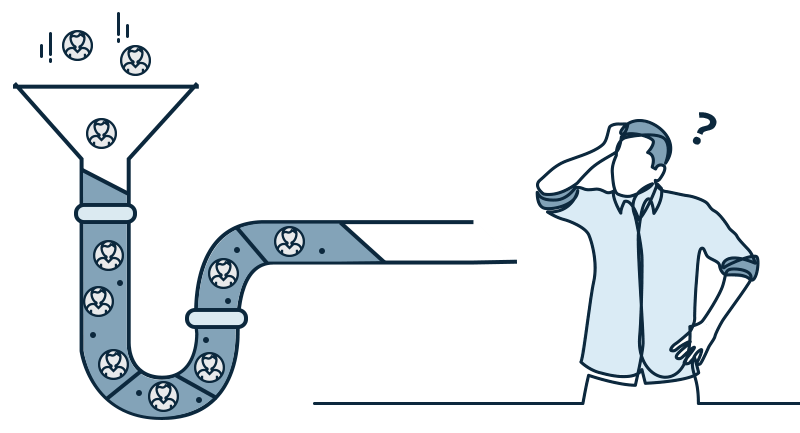
There are a few ways of managing your pipeline effectively. You can keep notes on paper, spreadsheets, or use a Pipeline Management CRM software. Whatever you choose, you not only need to record the information but also need to act on it. If managing multiple leads is like juggling eggs, ineffective pipeline management is like trying to catch them all in one hand.
Before we jump into the best practices for pipeline management, let’s understand what a pipeline looks like for different industries.
Examples of sales pipelines
While every business has its own sales or lead pipeline management system, the stages differ across industries. And the first stage of managing your sales pipeline is understanding the different stages you need to track. Here are a few examples of what pipelines look like for different industries:
1. Healthcare
The pipeline in healthcare industries usually focuses on the different stages of caregiving, from appointment scheduling to post-treatment follow-ups. Stages in a healthcare pipeline:
- Inquiry made
- Appointment scheduled
- Consultation with doctor
- Diagnosis
- Treatment
- Post-visit followup
- Feedback
2. Manufacturing
A Manufacturing CRM tracks lead movement through these stages:
- Prospecting
- Pre-qualification
- Proposal
- Negotiation
- Closing
- Post-sale support
3. SAAS
In a SAAS sales pipeline, multiple leads are at various SPANCO stages of the pipeline. SPANCO stands for:
- Suspect
- Prospect
- Analysis
- Negotiation
- Closing
- Order
4. Education
Higher education institutions and schools usually map admission pipeline stages to improve conversions. Stages in an admissions pipeline:
- Discovery
- Evaluating colleges
- Application
- Completing enrolment and payment
- Loyalty
5. Retail
In the retail industry, you can use pipeline management to track products through the supply chain. The most important stages are:
- Manufacturing
- Distribution
- Retail
- Customer
6. Financial Services
Pipeline management is important for financial services, especially lending, to track loan applications. The stages that they focus on are:
- Application
- Underwriting
- Approval
- Funding
These pipelines have a lot in common, since deals across all businesses flow in a similar manner. Here are a few tips that you can implement to manage pipelines.
5 Best practices for effective sales pipeline
1. Treat each lead as an individual
You can see the lead stage in the pipeline even with the most basic record-keeping methods. From this, you can work out what you need to do to get them to the next stage. However, if this is your only strategy, then you must be missing out on several opportunities.
Every lead will have different requirements, a different history, and a different budget. You can build a better relationship with each of them only when you treat them as an individual.
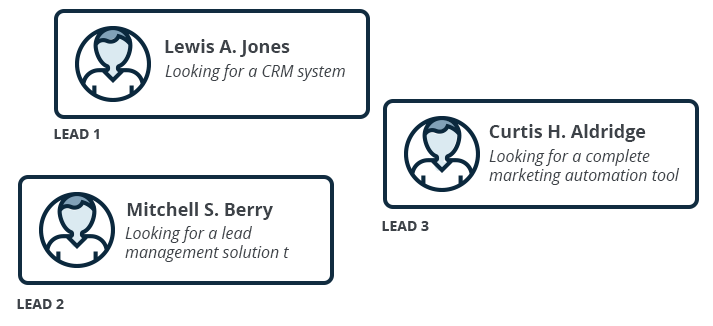
Let us take an example.
You have planned a promotional email campaign. You send the same message to thousands of people without segmenting them based on their preferences/interests. It will be a waste of effort as the recipients could not relate to the message. Also, blasting such emails may alert spam filters of email service providers. And then you will wonder why people don’t respond to your emails.
That is why you need to understand every individual’s preferences and segment them accordingly. It will help you craft personalized emails and other marketing campaigns.
Give it a thought – when you have put tremendous efforts to find those leads, why not put a little more effort to make them feel valued. And personalizing communication is the simplest way to do that.
2. Keep every detail intact
While talking to your prospects, make sure to keep notes of what they tell you. It is easy to forget small details and information, and the next time you get in touch, you may have forgotten what they wanted.
If your lead has to keep giving you the same information, again and again, they will soon get frustrated. Similarly, if you put forward a proposal that ignores what they asked for, you won’t be able to close the deal.
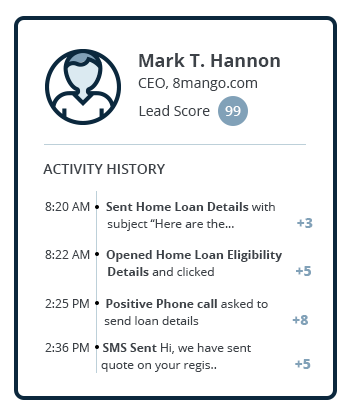
Attention to detail will impart a positive impression on your lead. It will help them trust your business. In turn, you will be able to close deals faster.
3. Learn to identify sales-ready leads
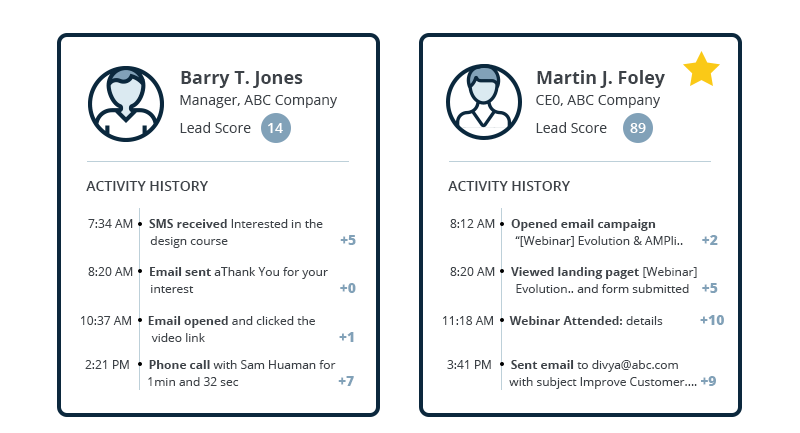
Of course, the goal of the sales pipeline is to convert every lead into a customer. However, different leads have different conversion patterns. For instance, a lead who has subscribed to your newsletter might not be sales-ready. On the other hand, a lead who has browsed your product page and tried to contact you for demo has more chances of conversion.
By monitoring the pipeline closely, you will learn to identify leads that have the potential to convert immediately.
Note these patterns. Refer to them often.
Being able to spot such leads will help you with the overall cash flow of the business. I am not saying that you should ignore other leads. But be aware that prioritizing sales-ready leads will give you more time to work on the hard deals.
Effective pipeline management has helped our admission counselors prioritize and reach the most engaged leads first.
– Kim Gasper, Corporate Director of Admissions, Asher College.
Read the case study.
4. Set up systems to save time
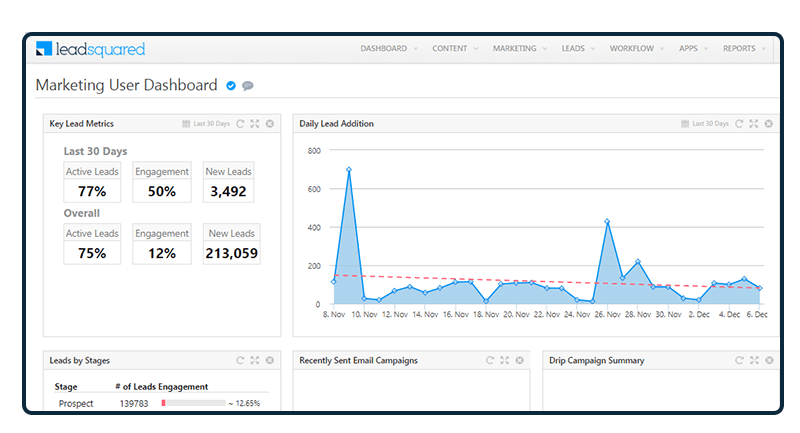
Using a digital system (online services, CRM, etc.) to manage your pipeline will save a lot of time in the long run. You will not have to sift through pieces of paper to find what you need. Nor will you have to resort to a calculator to find out ROI or any other metric you wish to track.
With a CRM system in place, you can generate reports in just a few clicks. You can even automate daily/weekly/monthly report generation.
You can also receive timely reminders on what the next thing is that you need to do. This way, you can focus more on the task at hand.
If you are a part of a sales team, then the information you record in the CRM system can be accessible to other team members. With a consistent information flow, every team member remains on the same page.
According to a LinkedIn study, 25% of sales reps change roles every year. Therefore, if somebody else has to follow-up with your prospect, they will have the full context of your interactions with them.
Thus, having software for sales pipeline management can help you streamline sales and build a better relationship with them.
5. Analyze and Improve
You must be already having an efficient process for sales pipeline management. Still, there will always be a scope of improvement.
Track and measure your activities and try to figure out how you can improve them further.
For instance, gather your salesforce and review reports. Find out what is working well and what is not. Identify bottlenecks that might be delaying the lead response time.
Automate manual processes and work on making your sales pipeline management more efficient. All these will help you build a scalable business of tomorrow.
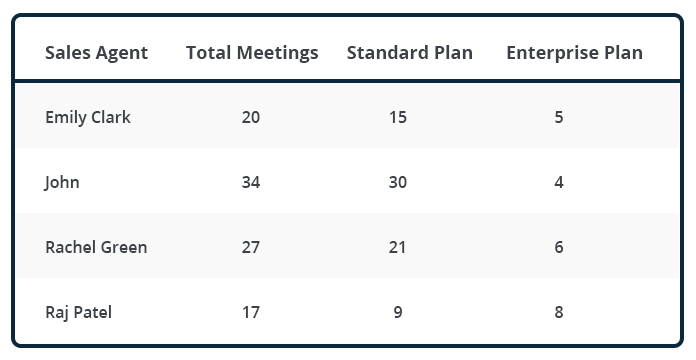
You need a few metrics or quantifiers to track your sales pipeline and measure your sales progress. Sales pipeline management metrics are just what you need.
Pipeline management metrics
1. Pipeline velocity: It measures the speed at which deals get closed through the sales pipeline.

2. Win rate: Win rate is usually calculated on opportunities that the sales team has qualified. It is an indicator of sales success.

3. Length of the sales cycle: Ideally, businesses aim to shorten their sales cycle to close deals faster. The metric depends on the kind of product/service your business sells, so there is no fixed benchmark, and you can aim to shorten it every quarter.

4. Customer acquisition cost: The metric refers to the cost of gaining a new client. With effective pipeline management, businesses can decrease the sales team’s contribution to the customer acquisition cost.

5. Conversion rate: The conversion rate is a measure of how effective your sales strategy is.

6. Customer Churn rate: Sales doesn’t end at deal closures. For long-term sales success, you need to retain customers and engage with them frequently.

By now, I am sure you’re convinced by how important sales pipeline management is for every business. We’ve covered a lot of the best practices but you still need a sales pipeline management system to reap the benefits. LeadSquared Sales Execution CRM is designed for high-velocity sales and simplified sales pipelines. Here’s what you can expect after implementing it:
Benefits of implementing a sales pipeline management system
1. Managers have a complete view of team performance and can easily forecast whether their team will meet its targets.
2. Your sales team will be way more productive if they know what to do next. Instead of spending hours planning their day, they can track leads at every stage of the pipeline and take relevant action on them.
3. Businesses can decrease sales bottlenecks with the right visibility into the entire sales process. They can also introduce training programs for the slowest pipeline stage, like negotiation.
4. Fewer bottlenecks speed up the sales process and boost revenue.
5. Sales pipeline management improves customer experience and satisfaction as well. When your salespeople understand the stage the prospects are stuck at, they can proactively reach out to them to resolve any challenges.
Ready to transform the way you hand sales pipelines? Book a demo with our team today!
FAQs
Sales Pipeline Management Software is a business tool that provides salespeople visibility into the sales process. It tracks the entire sales process – from the time the lead enters your system to conversion and beyond. Businesses generally use CRM software for sales pipeline management.
A sales pipeline is a visual representation of where the leads are in the sales process. It also shows you how many deals salespeople are expected to close in a given week, month, or quarter and how close a rep is to reaching their sales targets.
Pipeline management ensures that you don’t lose out on any deals and allows businesses to maximize sales outcomes without investing in additional resources. With constant visibility, both sales managers and sales reps are on the same page which improves sales productivity and forecasting.








![Conquering the Lead Generation Challenge in Higher Education [Webinar Recording] 14 Conquering the Lead Generation Challenge in Higher Education](https://www.leadsquared.com/wp-content/uploads/2021/11/Webinar-speakers-80x80.png)
